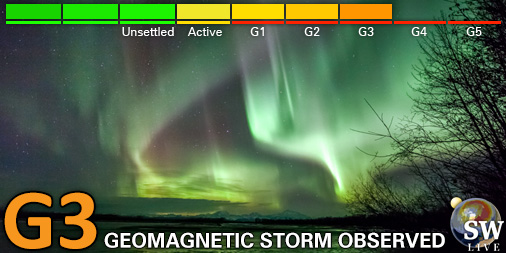Viewing archive of Monday, 17 November 2003
Solar activity report
Any mentioned solar flare in this report has a scaling factor applied by the Space Weather Prediction Center (SWPC). Because of the SWPC scaling factor, solar flares are reported as 42% smaller than for the science quality data. The scaling factor has been removed from our archived solar flare data to reflect the true physical units.
Report of Solar-Geophysical Activity 2003 Nov 17 2200 UTCPrepared by the NOAA © SWPC and processed by SpaceWeatherLive.com
Joint USAF/NOAA Report of Solar and Geophysical Activity
SDF Number 321 Issued at 2200Z on 17 Nov 2003IA. Analysis of Solar Active Regions and Activity from 16-2100Z to 17-2100Z
Solar activity has been moderate. Region 501 (N04E22)
has generated two M-class flares, an M1 x-ray event at 17/0134Z, and
an M4/1n event at 17/0905Z. The second event was accompanied by a
Type II radio sweep and a coronal mass ejection measured form the
LASCO coronagraph with an estimated speed of 1085 km/s. This region
underwent little change over the period and retains a beta-gamma
magnetic structure. Region 505 (S22E58) was newly numbered to day.
IB. Solar Activity Forecast
Solar activity is expected to be low
to moderate for the next three days. Region 501 will continue to
harbor a threat for M-class activity. Old active Regions 486 and
488 will be returning late in the period, and pose an increased
threat for M-class activity.
IIA. Geophysical Activity Summary 16-2100Z to 17-2100Z
The geomagnetic field has been at active to minor storm levels. The
favorably positioned coronal hole continued to cause high solar wind
speeds, and the accompanying southward Bz of the interplanetary
magnetic field, have kept the geomagnetic field activity at elevated
levels throughout the period. The greater than 2 MeV electron flux
at geosynchronous orbit reached high levels today.
IIB. Geophysical Activity Forecast
The geomagnetic field is
expected to be at predominantly unsettled to active levels for the
next two days. The coronal hole will pass from geoeffective
position, and the solar wind speeds should subside. On day three
(possibly late on day two) a glancing blow from the coronal mass
ejection that occurred on 17 Nov at 0917Z is anticipated, elevating
activity to periods of minor storm levels.
III. Event Probabilities 18 Nov to 20 Nov
| Class M | 50% | 55% | 55% |
| Class X | 05% | 10% | 10% |
| Proton | 05% | 10% | 10% |
| PCAF | green | ||
IV. Penticton 10.7 cm Flux
Observed 17 Nov 121 Predicted 18 Nov-20 Nov 135/155/165 90 Day Mean 17 Nov 128
V. Geomagnetic A Indices
Observed Afr/Ap 16 Nov 032/035 Estimated Afr/Ap 17 Nov 028/037 Predicted Afr/Ap 18 Nov-20 Nov 012/020-010/010-015/015
VI. Geomagnetic Activity Probabilities 18 Nov to 20 Nov
| A. Middle Latitudes | |||
|---|---|---|---|
| Active | 35% | 35% | 35% |
| Minor storm | 10% | 10% | 20% |
| Major-severe storm | 05% | 05% | 15% |
| B. High Latitudes | |||
|---|---|---|---|
| Active | 35% | 40% | 45% |
| Minor storm | 40% | 20% | 30% |
| Major-severe storm | 20% | 05% | 10% |
All times in UTC
Latest news
Latest forum messages
2025/04/12-13 Filament CMEs 2025/04/16 G3 Watch 476Coronal holes 51Filaments and prominences 67AR4064 9Incoming & Unnumbered Active Regions 1742
More topicsSupport SpaceWeatherLive.com!
A lot of people come to SpaceWeatherLive to follow the Sun's activity or if there is aurora to be seen, but with more traffic comes higher server costs. Consider a donation if you enjoy SpaceWeatherLive so we can keep the website online!

Latest alerts
Wednesday, 16 April 2025
21:45 UTC - Geomagnetic activity
Minor G1 geomagnetic storm (Kp5) Threshold Reached: 21:36 UTC
21:00 UTC - Geomagnetic activity
Severe G4 geomagnetic storm (Kp8) Threshold Reached: 20:55 UTC
19:45 UTC - Geomagnetic activity
Strong G3 geomagnetic storm (Kp7) Threshold Reached: 19:25 UTC
19:00 UTC - Geomagnetic activity
Moderate G2 geomagnetic storm (Kp6) Threshold Reached: 18:38 UTC
18:45 UTC - Geomagnetic activity
Minor G1 geomagnetic storm (Kp5) Threshold Reached: 18:28 UTC
Space weather facts
| Last X-flare | 2025/03/28 | X1.1 |
| Last M-flare | 2025/04/15 | M1.2 |
| Last geomagnetic storm | 2025/04/16 | Kp8- (G4) |
| Spotless days | |
|---|---|
| Last spotless day | 2022/06/08 |
| Monthly mean Sunspot Number | |
|---|---|
| March 2025 | 134.2 -20.4 |
| April 2025 | 120.7 -13.5 |
| Last 30 days | 120.8 -19.6 |







